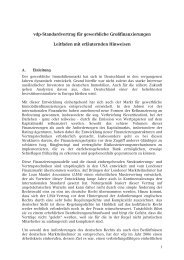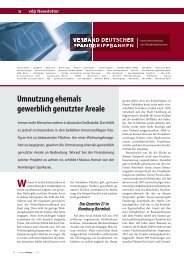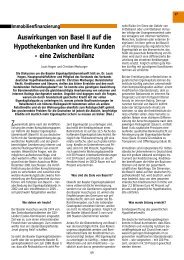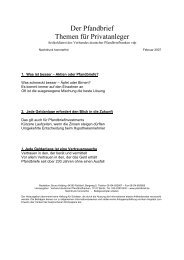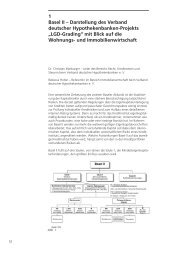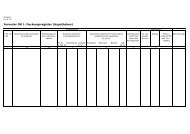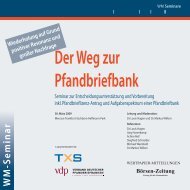The Pfandbrief 2011 | 2012
The Pfandbrief 2011 | 2012
The Pfandbrief 2011 | 2012
Create successful ePaper yourself
Turn your PDF publications into a flip-book with our unique Google optimized e-Paper software.
Spread and counterparty risk<br />
<strong>The</strong> equivalent under Solvency II to credit risk in banking regulation is spread and counterparty<br />
default risk. However, securities assigned to spread risk do not have to be allocated to<br />
counterparty default risk or vice-versa. <strong>The</strong> spread risk reflects the risk of the widening of<br />
credit spreads. It thus describes the changes in market value resulting from an increase in the<br />
yield differential above the risk-free yield curve. <strong>The</strong> spread risk applies to the majority of the<br />
interest-based securities in the portfolio, including asset-backed securities and credit risks<br />
transferred via credit derivatives. <strong>The</strong> counterparty default risk, in contrast, covers the counterparty<br />
risks of derivatives and other risk-mitigating agreements as well as all securities that are<br />
not allocated to the spread risk. <strong>The</strong> latter item primarily relates to mortgage and insurance<br />
policy loans that have been granted.<br />
Both Public <strong>Pfandbrief</strong>e and Mortgage <strong>Pfandbrief</strong>e are subject to spread risk. In contrast to<br />
all other interest-bearing securities allocated to spread risk, the risk factors for <strong>Pfandbrief</strong>e in<br />
QIS5 were lower. However, this is only the case for covered bonds as defined in the Directive<br />
on Undertakings for Collective Investment in Transferable Securities (UCITS) that have a AAArating.<br />
This is intended to reflect the particularly high level of safety offered by these securities.<br />
In QIS5, the capital requirement for a <strong>Pfandbrief</strong> designed as a zero-coupon bond with a<br />
maturity of 10 years was around 6%. This requirement is thus around three percentage points<br />
lower than that for an unsecured corporate bond with the highest credit rating, for which<br />
around 9% of the market value had to be deposited (cf. figure 1).<br />
39<br />
Fig. 1:<br />
Spread risk: Capital requirement as percentage of debt instrument<br />
on market value basis<br />
Spread risk I<br />
Corporate bond (AAA) <strong>Pfandbrief</strong> (AAA)<br />
35%<br />
30%<br />
25%<br />
20%<br />
15%<br />
10%<br />
5%<br />
0%<br />
1 2 3 4 5 6 7 8 9 10 15 20 30 40 50<br />
Maturity (years)




